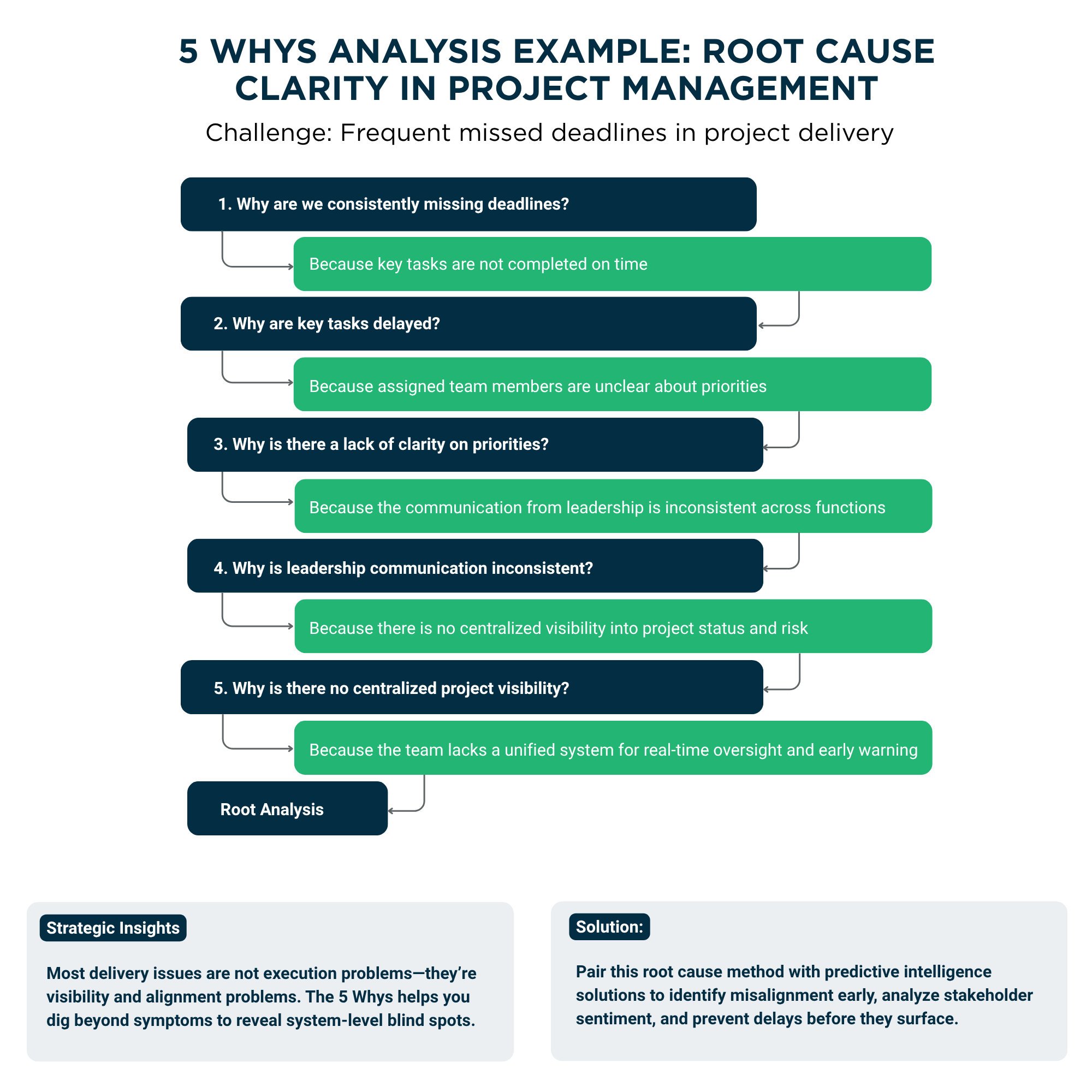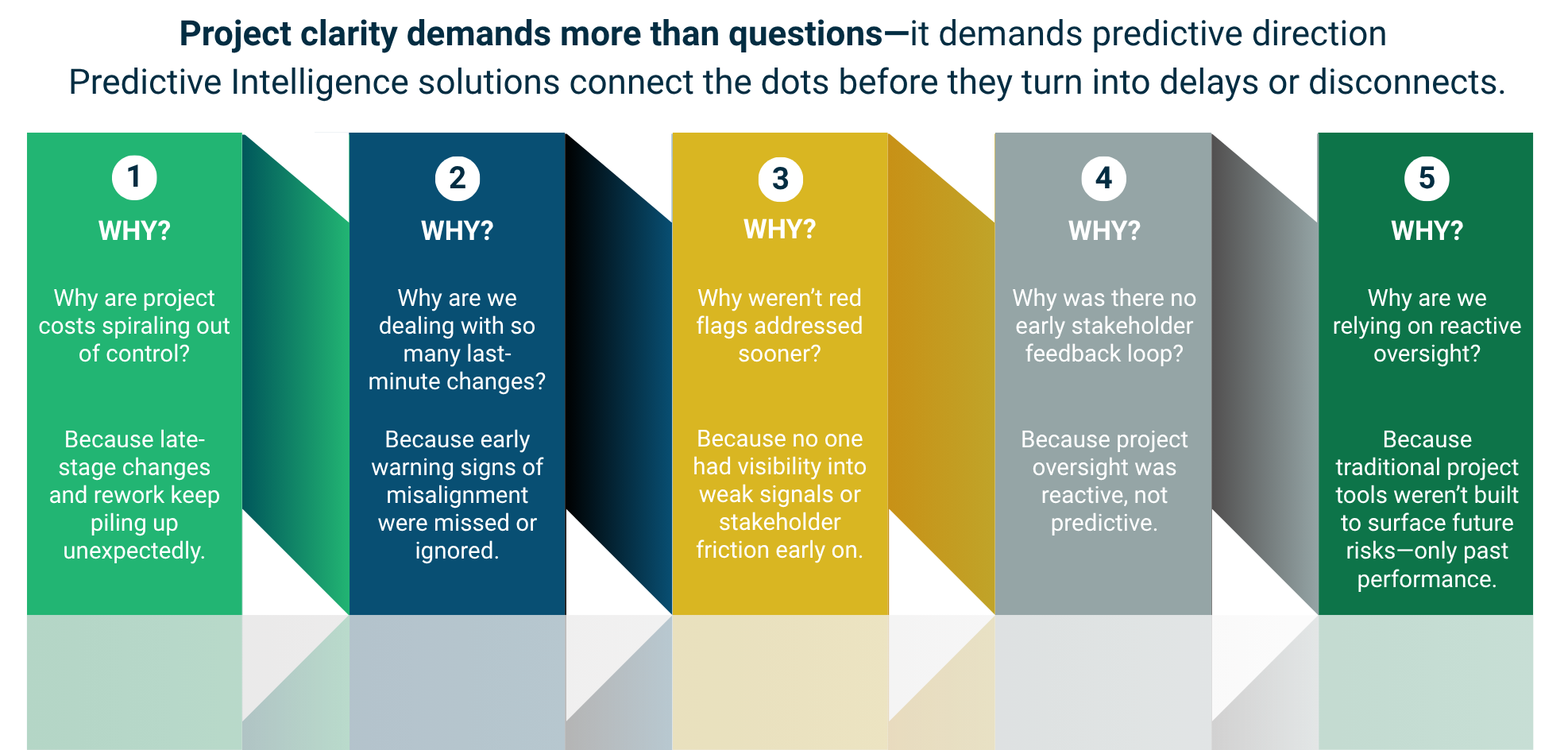
Quick Summary: The 5 whys approach empowers project leaders to uncover root causes, optimize efficiency, and build stakeholder trust, evolving into a strategic asset with predictive intelligence. Its integration with data-driven foresight and authoritative insights from PMI ensures measurable success and proactive risk management across modern projects.
Project management in 2025 demands precision amid growing complexity. Executives today are navigating hybrid work environments, tighter delivery windows, and heightened scrutiny on stakeholder alignment and risk resilience. In this volatile climate, surface-level analysis isn’t enough. Leaders must diagnose deeper—faster. The 5 Whys approach emerges as a powerful yet straightforward method to mitigate project challenges by tracing them back to their root cause. Developed as part of the Toyota Production System, this technique has since matured into a universal problem-solving framework, now reshaped for modern project ecosystems.
This article explores how the 5 Whys can be strategically applied in today’s projects—moving from fundamentals to execution, adaptation to optimization, and eventually pairing with predictive technologies for even greater foresight. For leaders steering complex portfolios, the 5 Whys offers not just a method, but a mindset and discipline—one that fosters clarity, accountability, and smarter decision-making.
Understanding the 5 Whys Approach Fundamentals
 At its essence, the 5 Whys is a structured line of inquiry - you ask “why” repeatedly—typically five times—to peel away the symptoms and reveal the true cause of a problem. What makes it impactful in a project setting is its ability to cut through noise, prioritize the right issues, and promote meaningful correction rather than superficial fixes.
At its essence, the 5 Whys is a structured line of inquiry - you ask “why” repeatedly—typically five times—to peel away the symptoms and reveal the true cause of a problem. What makes it impactful in a project setting is its ability to cut through noise, prioritize the right issues, and promote meaningful correction rather than superficial fixes.
Its value lies in five core strengths:
- Identifies Core Issues - By not stopping at the first or most visible reason, it uncovers the real blockers—such as a delivery delay rooted in incomplete requirements gathering, not just poor execution.
- Encourages Team Collaboration - The process brings cross-functional teams together, surfacing diverse perspectives and avoiding bias-laden conclusions.
- Supports Data-Driven Insights - Unlike ad-hoc troubleshooting, the 5 Whys thrives when each layer of questioning is validated with available project data.
- Promotes Accountability - Rather than assigning blame, it redirects focus to where the system or process needs fixing—enabling long-term correction.
- Builds a Learning Culture - Each cycle of analysis strengthens organizational knowledge, equipping teams to avoid repeat mistakes and move forward stronger.
According to PMI’s Pulse of the Profession, organizations that consistently use structured problem-solving tools like the 5 Whys report 30% higher project success rates. That’s not a marginal gain—it’s a measurable shift in delivery outcomes.
Ready to go from analysis to action? TrueProject’s QuickStart plan brings structure to your process with predictive guardrails built right in—so you’re not just asking “why,” you’re solving the right things faster.
Implementing the 5 Whys Approach in Project Execution
With its foundational logic clear, the next step is to integrate the 5 Whys into everyday project workflows—where deadlines are tight, risks are layered, and root cause clarity is often missing. Execution is where the theory is stress-tested.
Here's how to apply the approach effectively in practice:
- Defines Problems Precisely - Clearly state the issue—for example, “15% budget overrun in Q2” instead of vague statements like “budget went off track.”
- Guides Iterative Questioning - Ask “why” step-by-step, grounding each answer in data to avoid assumptions and hasty conclusions.
- Integrates Stakeholder Input - Involve relevant teams early—cross-functional input often reveals hidden gaps and builds solution buy-in.
- Drives Actionable Solutions - Link root causes to concrete actions, like refining estimates or clarifying team roles.
- Aligns with Project Timelines - Use 5 Whys during sprint reviews or retrospectives to embed learning without slowing delivery.

According to PMI, combining structured problem-solving with inclusive collaboration can reduce project risks by up to 20%. Seeing this process in action can provide clarity for leaders aiming to refine their project workflows.
You don’t have to figure it out alone. See how TrueProject surfaces the right risks and root causes—before they spread. Let’s walk you through it live.
Adapting the 5 Whys Approach to Modern Project Trends
While its origins lie in lean manufacturing, the 5 Whys approach has matured into a dynamic problem-solving technique for modern project ecosystems. Today’s project leaders are contending with fragmented communication across hybrid teams, evolving sustainability mandates, and increasingly agile delivery cycles. To remain effective, the 5 Whys must evolve alongside these shifts for the gap analysis:
- Enhances Hybrid Team Communication - Exposes gaps like unclear ownership or fragmented tools, enabling better alignment across remote teams.
- Supports Sustainable Practices - Helps spot inefficiencies—like redundant reviews or bloated approvals—driving leaner, digital workflows.
- Leverages Data Analytics - Anchors each “why” in real-time project metrics, making the analysis sharper and more evidence-based.
- Facilitates Agile Integration - In retrospectives, helps teams move past surface-level blockers to fix root issues that stall sprints.
- Addresses Regulatory Compliance - Flags process gaps early, reducing risk of audit failures or delivery delays.
High-performing organizations integrate trend-aligned problem-solving strategies to stay competitive. Experiencing a practical demonstration can help leaders align this method with evolving priorities.
Curious how future-ready teams solve hybrid friction, agile gaps, and sustainability misfires—all at once? Let TrueProject show you what adaptive governance really looks like.
Overcoming Challenges in the 5 Whys Approach Application
As with any structured method, the 5 Whys approach isn’t immune to missteps. Whether it’s jumping to conclusions too quickly or lacking a cross-functional lens, these challenges can limit the value of the process unless consciously addressed:
- Mitigates Subjectivity Risks - Involving multiple team members and grounding each answer in evidence keeps the analysis objective and credible.
- Handles Complex Issues - Use complementary tools like fishbone diagrams or SIPOC when issues have multiple root causes.
- Manages Time Constraints - Short, focused analysis sessions during reviews preserve depth without slowing momentum.
- Avoids Premature Closure - Resist stopping at early answers—commit to the full process for more reliable solutions.
- Enhances Team Buy-In - When teams see their input reflected in real actions, trust and engagement naturally grow.
The risk exposure drops significantly when structured problem-solving is paired with proactive challenge management. Let’s explore how the 5 whys approach in project management optimizes project efficiency.
Optimizing the 5 Whys Approach for Project Efficiency
Once the fundamentals are mastered and common pitfalls addressed, the next evolution is optimization—scaling the 5 Whys into a nimble yet reliable instrument that drives speed, accuracy, and alignment across large initiatives.
- Streamlines Problem Identification - Standardized templates remove ambiguity and help teams start with a clear, measurable issue.
- Integrates Real-Time Data - Feeding live project metrics into the process sharpens insights and speeds up decisions.
- Automates Follow-Up Actions - Linking root causes to PM tools (like Kanban or backlog trackers) ensures execution and accountability.
- Customizes for Project Type - Adjust questioning depth based on complexity—avoiding overkill for simple issues, and digging deeper when needed.
- Boosts Cross-Functional Alignment - Sharing 5 Whys results across teams builds collective learning and prevents repeat issues.
Advanced problem-solving practices can improve delivery timelines by up to 25%. That’s not just faster—it’s smarter, more coordinated execution.
Let’s understand how this translates into measurable performance improvements across the project lifecycle.
Measuring the Impact of the 5 Whys Approach on Project Outcomes
Optimizing a methodology is only valuable if its results can be measured. For project leaders, assessing the effectiveness of the 5 Whys approach is crucial—not just to validate its use, but to ensure strategic alignment across projects. This measurement phase closes the loop on learning, turning reactive fixes into proactive advantage:
- Tracks Key Performance Indicators - Metrics like on-time delivery, rework rates, and cost variance quantify progress after analysis.
- Conducts Post-Implementation Reviews - Scheduled check-ins confirm whether root causes were resolved and actions held.
- Captures Team Feedback - Insights from team experiences reveal morale shifts, process clarity, and perceived value.
- Builds a Knowledge Repository - Documented analyses serve as reusable assets for onboarding, training, and future fixes.
- Evaluates Long-Term Trends - Repeated root causes flag broader issues—like poor estimates or systemic bottlenecks—driving portfolio-level improvements.
The Project Management Institute emphasizes that organizations that measure structured problem-solving impact see a 20% increase in project success rates. That’s more than operational—it’s strategic.
Enhancing Stakeholder Trust with the 5 Whys Approach
When performance improvements are visible and traceable, stakeholder confidence rises. But trust isn't just about outcomes—it's about transparency in how problems are solved. The 5 Whys approach fosters this trust through openness, inclusivity, and actionable communication:
- Promotes Transparency - Sharing both the process and outcomes with stakeholders signals maturity and a proactive culture.
- Incorporates Diverse Perspectives - Including clients, sponsors, and teams ensures solutions reflect what matters most.
- Delivers Actionable Updates - Concise findings tied to next steps keep stakeholders informed and aligned—without overload.
- Addresses Concerns Proactively - Using the 5 Whys on stakeholder issues (like delays or scope creep) shows responsiveness over defensiveness.
- Supports Governance Standards - Documented root cause analysis builds confidence in control, compliance, and accountability.

Strengthening stakeholder trust through the 5 Whys approach relies on transparency and proactive solutions, a principle backed by PMI’s research on satisfaction improvements. Leaders can quickly test this approach with the right solutions to build confidence and alignment.
Try TrueProject QuickStart to experience how the 5 whys approach enhances stakeholder trust in your projects today.
Integrating Predictive Intelligence with the 5 Whys Approach
Once foundational discipline is in place, the next strategic leap is pairing the 5 Whys with predictive intelligence. While the 5 Whys identifies why something went wrong, predictive analytics helps you act before it does. Together, they create a proactive feedback loop that elevates foresight into real-time risk mitigation:
- Forecasts Potential Issues - Predictive signals—like effort misalignment or dropping engagement—trigger early root cause analysis before problems escalate.
- Enhances Proactive Planning - Merging trend predictions with structured analysis helps prevent issues at the source—not just explain them after.
- Improves Decision Accuracy - Real-time, AI-driven insights sharpen the “why” process, enabling faster, more focused questioning.
- Supports Scenario Analysis - Predictive models simulate outcomes that the 5 Whys can validate or challenge with evidence-based inquiry.
- Drives Continuous Innovation - The cycle of predicting, questioning, and improving keeps teams adaptive and ahead of change.
Still mapping problems after the damage is done? See how TrueProject flips foresight into your frontline advantage—watch how predictive intelligence changes everything.
Conclusion
Root cause thinking is no longer a reactive exercise—it’s a leadership expectation. The 5 Whys approach, when applied with intent, gives teams the discipline to stop circling symptoms and start addressing what actually holds projects back. But what matters most is how quickly leaders can act on it, and whether their teams are equipped to respond with clarity and coordination.
That’s where structure and foresight come in. When supported by modern project intelligence—predictive insights, early risk signals, and real-time alignment—the 5 Whys evolves into a catalyst for better decisions and stronger outcomes.
TrueProject, a customized KPI-based predictive SaaS solution for project management, enables this shift with purpose-built capabilities that turn insight into strategic control. It delivers early warning signals before issues escalate, continuously monitors stakeholder sentiment to surface invisible friction, and uses AI to recommend precise, risk-adjusted actions. From automated governance simulations to deep portfolio-level visibility, TrueProject gives project leaders the clarity to act—not react. It’s not a dashboard. It’s an intelligence layer for making strategic decisions. One that brings confidence, consistency, and command to every phase of execution.
Every project leaves clues. TrueProject connects the dots you can’t see—through stakeholder signals, risk foresight, and AI-backed clarity. Explore what that means for your portfolio.
FAQs
1. What is the 5 Whys approach in project management?
The 5 Whys is a root cause analysis method that helps project teams identify the underlying reason behind a problem by asking “why” up to five times, drilling past symptoms to reach the source.
2. How do you apply the 5 Whys to uncover root causes in a project?
Start with a clear problem statement, then ask “why” repeatedly—each answer becoming the basis for the next question—until you reveal the root cause. Involve stakeholders and use data to validate each step.
3. Why is the 5 Whys method still relevant in modern project environments?
It offers a fast, simple, and collaborative way to tackle recurring issues—especially valuable in agile, hybrid, and fast-paced projects where clarity and speed matter most.
4. How does TrueProject enhance the 5 Whys technique with predictive intelligence?
It adds foresight by identifying risks and early signals before they escalate, enabling teams to focus the 5 Whys on what truly matters—leading to faster decisions and fewer surprises.






